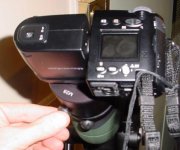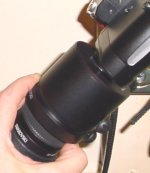If I've got the hang of this forum software, David, then
here these samples here should answer your question. I'm getting some good pictures, but also still getting heaps of duds. Gradually, ever so gradually, I am learning to get more good pics and fewer duds, but it's hard.
Give me an easy enough subject and I'll get decent results pretty much every time now. (For example, a nice largish bird such as a duck, that's reasonably close, that keeps more-or-less still for several minutes at a time while I fiddle about, and with good, bright light. That's at one extreme. With half-decent gear and a little practice, anyone ought to be able to do that.
At the other extreme are the problem birds - essentially, the ones that break one or more of the "rules" above and make photography difficult. It's all a matter of degree, I think. Things like thornbills or scrub-wrens tend to be very difficult. I still haven't got any decent thornbill pictures even though the tiny little things don't mind me getting close to them, as they are moving constantly and (90% of the time) they are ducking in and out of the shrubbery, making it difficult (a) to get good light on them, and (b) to get the Nikon to auto-focus on the right thing.
But I will, eventually. I'm not in too much of a hurry as, come the summer, I'll be able to lie in wait at watering places and get as many as I like.
Anyway, the short answer is that I'm finding it incredibly rewarding and just as difficult as I want to make it. This weekend, for example, I could have taken any number of nice easy water bird pictures but instead set myself the goal of getting passerine shots. The results are not great and I don't have much to show for it (a handful of reasonable shots is all) but no pain, no gain. Little by little, I'm improving.
My main grumble with the Coolpix is that interminable damn shutter delay. But what can you do? If there is a better digiscoping camera, I'll order one on Monday. In the meantime, we just have to learn to live with the Nikon.






